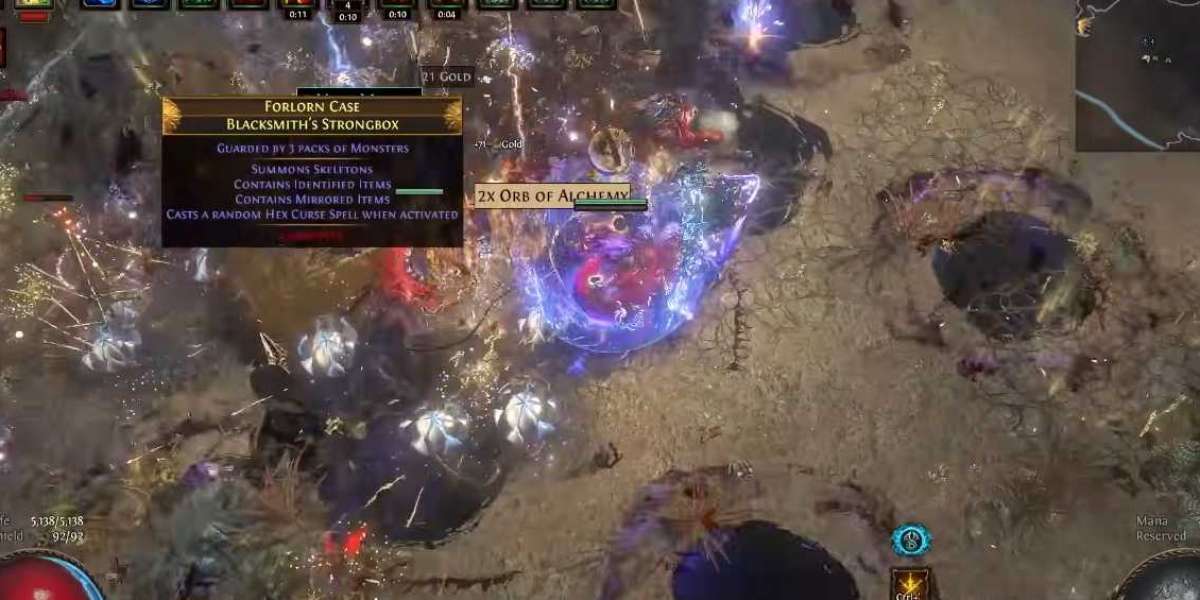Welcome to Path of Exile—one of the most complex and rewarding action RPGs ever created. Developed by Grinding Gear Games, POE offers a deep world of dark fantasy, limitless build customization, and challenging endgame content. As a new exile cast upon the shores of Wraeclast, your journey will be harsh, filled with deadly monsters, cryptic mechanics, and incredible rewards.
This beginner’s guide will help you start your adventure in Wraeclast confidently—covering classes, leveling, skill gems, gear, and long-term progression strategies. Whether you aim to crush bosses or master the economy, this is where your legend begins.
1. Understanding Path of Exile’s Core Gameplay
At its heart, Path of Exile is an action RPG similar to Diablo II, but far more intricate. You’ll slay enemies, gather loot, and level up—but every decision, from skill choices to item mods, can shape your fate.
Key Features That Define POE
Massive Passive Skill Tree: Over 1,300 nodes to customize your character.
Skill Gem System: Abilities come from gems socketed into your gear.
Deep Crafting and Trading: Build wealth through smart trading or crafting rare items.
Seasonal Leagues: Each new league introduces fresh mechanics, monsters, and challenges.
Wraeclast rewards knowledge and preparation—understanding how systems interact is essential for long-term success.
2. Choosing Your Starting Class
Your starting class determines your starting point on the passive skill tree and your initial playstyle. However, any class can eventually reach any part of the tree—so choose based on comfort, not fear of being locked in.
Classes Overview
ClassPrimary AttributesPlaystyle
MarauderStrengthMelee powerhouse with high life and defense.
RangerDexterityAgile ranged fighter with speed and evasion.
WitchIntelligenceFocused on spells, minions, and elemental power.
DuelistStrength/DexterityBalanced melee fighter with offense and mobility.
TemplarStrength/IntelligenceHybrid caster-warrior with lightning or support skills.
ShadowDexterity/IntelligenceTricky assassin using traps, poisons, or critical strikes.
ScionAll attributesUnlocks after Act 3; highly POE currency flexible and advanced.
Beginner Recommendation
If you’re new, start with Marauder (Melee), Ranger (Bow), or Witch (Spellcaster). These classes are forgiving and supported by easy-to-follow early builds.
3. Mastering the Skill Gem System
Unlike most RPGs, Path of Exile doesn’t give you abilities through leveling. Instead, Skill Gems grant attacks, spells, and auras—each linked to your gear.
Gem Basics
Active Skill Gems: Provide abilities (e.g., Fireball, Cyclone).
Support Gems: Modify active skills (e.g., add damage, chain effects).
Sockets and Links: Place gems into socketed gear; linked sockets allow supports to affect skills.
Example:
A Fireball gem linked to Added Lightning Damage and Increased Critical Strikes creates a stronger spell.
Gear with 3–6 linked sockets enables powerful combinations.
Tip: Always match gem colors with socket colors—red (Strength), green (Dexterity), blue (Intelligence).
4. The Passive Skill Tree – Plan Ahead
The Passive Skill Tree is enormous and can intimidate new players. But its design allows endless flexibility.
Beginner Advice
Follow a beginner build guide from MMOexp or community sources until you understand synergy.
Focus early points on Life, Resistances, and Damage Nodes.
Avoid spreading too wide across the tree—you’ll waste passive points.
Remember, respec points are limited; smart early planning saves headaches later.
5. Leveling Efficiently Through the Acts
Path of Exile features 10 story acts, which you’ll complete before unlocking the Atlas of Maps (endgame).
Leveling Tips for Beginners
Follow the main questline closely—side areas are optional early on.
Upgrade gear frequently; use rare items with good resistances.
Cap your elemental resistances (75%) before Act 5+—this is vital for survival.
Use Movement Skills like Dash, Leap Slam, or Flame Dash for speed.
Pick up Orb of Transmutation, Alteration, and Alchemy—they’re essential for crafting.
By the end of Act 10, aim for level 70+ and a build ready to face maps.
6. Gearing and Crafting Fundamentals
In POE, gear determines everything—from raw power to survival chances. Unlike traditional RPGs, every item drop can be modified and improved.
Gear Rarity
TypeColorDescription
NormalWhiteBasic item with no modifiers.
MagicBlue1–2 modifiers.
RareYellow3–6 modifiers (ideal for most builds).
UniqueBrownSpecial fixed items with unique effects.
Important Item Stats
Life and Resistances: Always prioritize these.
Damage Mods: Look for flat or percentage increases.
Movement Speed (Boots): Improves gameplay flow.
Crafting Tips
Use Orb of Alchemy to upgrade white items into rares.
Chaos Orbs reroll stats on rare gear.
Use Essences and Fossils for targeted crafting.
Don’t hoard everything—learn what’s valuable through experience or trade tools.
7. The Economy and Trading
POE has a player-driven economy with no gold—everything revolves around currency orbs (used for both trade and crafting).
Common Currencies
CurrencyPurpose
Orb of TransmutationUpgrade a normal item to magic
Orb of AlchemyUpgrade a normal item to rare
Chaos OrbRe-roll item modifiers
Exalted OrbAdd a new modifier to rare items
Divine OrbAdjust numeric values on mods
Trading is done via the official trade site or community platforms. Learning item values is crucial for long-term wealth.
Tip: Always price-check rare items before selling; some can be worth dozens of Chaos Orbs.
8. Flask Management and Survival
Flasks are not just healing potions—they’re part of your build.
Flask Types
Life Flasks: Restore health over time.
Mana Flasks: Restore mana.
Utility Flasks: Grant buffs (armor, movement, resistances).
Useful Flask Modifiers
“of Heat” – Removes Freeze.
“of Staunching” – Removes Bleed.
“of Warding” – Removes Curses.
Always maintain 1–2 Life Flasks, 1 Mana Flask, and 2 Utility Flasks for survivability.
9. Ascendancy Classes – Power Up Your Build
After completing Labyrinth Trials, you unlock Ascendancy Classes, which provide specialized bonuses.
Examples:
Base ClassAscendancySpecialty
MarauderJuggernautImmovable tank
RangerDeadeyeRanged critical DPS
WitchNecromancerMinion summoner
DuelistSlayerLifesteal melee fighter
TemplarInquisitorElemental spell damage
ShadowAssassinPoison crit specialist
Ascendancies define your endgame playstyle—choose wisely based on your build’s focus.
10. Mapping – Entering the Endgame
After finishing Act 10, you’ll access the Atlas of Maps, the foundation of POE’s endgame. Maps are randomized dungeons with different monsters, bosses, and loot modifiers.
Mapping Tips
Start with white (Tier 1–5) maps to build confidence.
Use Alchemy Orbs to make maps rare for better loot.
Upgrade your Atlas Bonus by completing maps of each tier.
Don’t skip Map Bosses—they drop valuable completion rewards.
Once you master maps, you can push into advanced systems like Delve, Heist, Metamorph, and Sanctum.
11. League Mechanics and Seasonal Play
Every few months, a new League begins, resetting the economy and introducing fresh mechanics (e.g., Breach, Expedition, Necropolis).
Why Play Leagues?
Clean slate for everyone.
New items and gameplay systems.
Exclusive cosmetics and rewards.
Always start in the current league—it’s where the player base and economy are most active.
12. Building a Character Like a Pro
Even if you’re new, a few universal rules will help you build effectively:
Balance Offense and Defense: Damage is meaningless if you die instantly.
Cap Resistances: Aim for 75% Fire, Cold, and Lightning resistances by Act 6.
Invest in Life Nodes: At least 100–120% increased life from passives by midgame.
Upgrade Gear Regularly: Replace outdated items every few acts.
Follow a Build Guide: MMOexp offers tested beginner builds each league.
Good builds are designed for survival first—then scaling damage later.
13. Currency Farming and Long-Term Goals
Once you reach maps, your goal shifts from leveling to wealth building.
Ways to Farm Currency
Mapping: Run high-tier maps efficiently.
Delve: Mine fossils and resonators.
Heist: Steal valuable artifacts.
Essence Expedition Farming: Targeted loot strategies.
Trade Flipping: Buy low, sell high on trade sites.
With time, you’ll accumulate Chaos Orbs, Divine Orbs, and even Exalted Orbs—your ticket to crafting god-tier gear.
14. Common Beginner Mistakes to Avoid
Ignoring resistances – Biggest reason new players die after Act 5.
Using every skill gem – Focus on one main skill + supports.
Skipping movement skills – You’ll die more often without mobility.
Neglecting flask mods – They can save your life in tough fights.
Not following a build plan – The skill tree punishes random allocation.
Avoid these pitfalls, and your first league experience will be much smoother.
15. Final Thoughts – Survive, Adapt, and Conquer Wraeclast
Path of Exile is not a casual game—it’s a deep, ever-evolving world that rewards knowledge, planning, and perseverance. Every decision matters, and every failure teaches you something valuable.
Your journey in Wraeclast will begin with chaos and confusion, but soon you’ll understand the rhythm of combat, the beauty of perfect gear rolls, and the thrill of conquering your first red-tier map.
So, exile—gather your strength, socket your gems, and step into the darkness. With patience and skill, you’ll carve your path to power.
For more detailed Path of Exile guides, currency tips, and efficient buy POE currency build strategies, visit MMOexp—your trusted source for MMO insights and progression resources.
Keywords: Path of Exile beginner guide, MMOexp POE guide, POE leveling tips, POE skill tree guide, POE mapping, POE economy, POE crafting guide, Wraeclast survival, MMOexp Path of Exile








